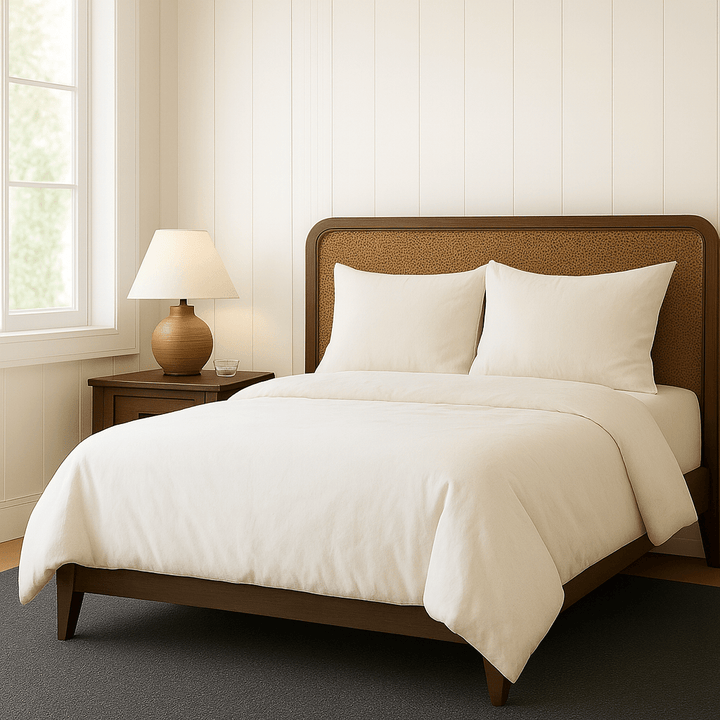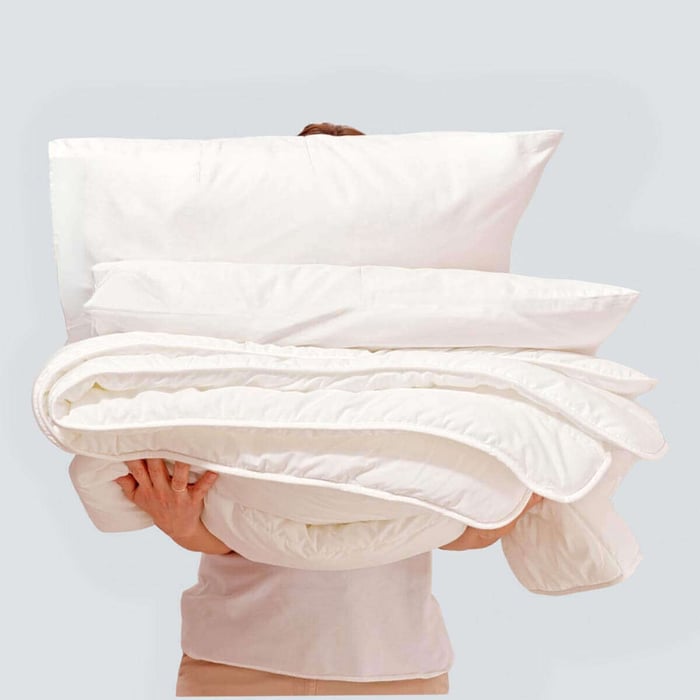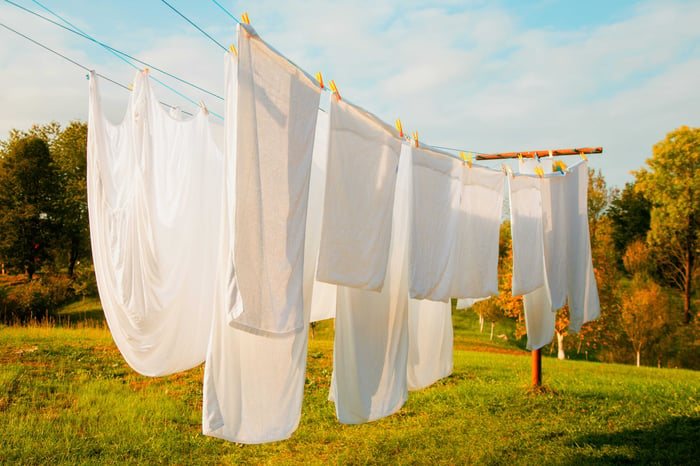Table of Contents
- What Does “Active Fiber” Actually Mean?
- The Science Behind Wool’s Thermal Magic
- Why Passive Fibers Can’t Compete
- Warmth Without Weight: The Airlay Advantage
- The “Smart” Fiber Nature Can Teach From
- Why Wool Feels Warmer Than It Looks
- Sustainability: Comfort That Restores, Not Consumes
- How Wool Balances Warmth and Breathability
- Practical Warmth: How to Layer for Best Results
- The All-Season Secret
- The Comfort Chemistry: How Wool Generates Warmth
- Warmth Reimagined: Rest the Way Nature Intended
- FAQs on Wool Duvet Inserts, Comforters & Sustainable Bedding
Why Wool Actively Keeps You Warm All Night
If you’ve ever climbed into bed feeling warm only to wake up cold a few hours later, you’re not alone. Many comforters act like static insulators — they trap heat but can’t adapt. Wool is different. As part of active fiber bedding, it constantly responds to your body temperature and environment, keeping you perfectly warm without overheating.
This post explains why wool behaves like a living system, how its fiber structure regulates heat and moisture, and why active fiber bedding is the key to deeper, more restorative sleep.
What Does “Active Fiber” Actually Mean?
When we call wool an active fiber, we mean it’s dynamic — it interacts with its surroundings instead of simply blocking or storing heat.
Unlike synthetic or cotton fibers that passively insulate, wool breathes and responds to your body’s temperature, humidity, and movement. Each fiber can absorb and release moisture vapor as needed, keeping your sleep environment in balance.
That’s what makes wool bedding (active fiber bedding) uniquely comfortable in both winter and summer — it reacts to you.
The Science Behind Wool’s Thermal Magic
1. Crimped Structure = Natural Insulation
Wool fibers are naturally crimped, forming millions of microscopic air pockets. These pockets trap body heat in a lightweight layer, creating natural insulation without heaviness.
Unlike flat cotton fibers or slick synthetics, wool’s spring-like structure maintains loft and warmth even under compression. That’s why lightweight wool comforters can feel thinner but insulate better than bulky down alternatives.
Organic Wool Duvet Insert & Bedding Set | Sustainable & Regenerative | Made in New Zealand

$475.15
$559.00
Cooler Nights & Deeper Sleep — All Year Long If you’re searching for the perfect organic wool duvet insert and wool bedding set, this complete set includes both the duvet insert and cover. Our organic wool duvet set, designed using… read more
2. Hygroscopic Fibers That Generate Gentle Heat
Here’s where wool’s active properties really shine.
Wool is hygroscopic, meaning it absorbs water vapor from the air (or from your body). When this happens, a small amount of heat — known as the heat of sorption — is released.
So when humidity rises in your bed (say, you start to perspire slightly), wool absorbs that moisture and gently releases warmth, maintaining your comfort zone naturally.
This isn’t marketing — it’s chemistry. The molecular bonds inside wool fibers shift as they take in vapor, converting that energy into heat. It’s what makes wool feel cozy without clamminess — and why it’s ideal for temperature-regulating bedding.
3. Moisture Management for a Dry Warmth
Wool can absorb up to 30% of its own weight in moisture vapor without ever feeling damp.
That’s more than any other natural fiber.
This invisible moisture exchange prevents the chills that occur when sweat evaporates on your skin. Instead, the active fiber bedding traps warmth while keeping humidity in check — the definition of active insulation.
Your body stays warm, dry, and balanced — not sweaty or sticky like under polyester or down.
Organic Cotton Sheets – Soft, Breathable & Sustainable

$189.00
Softer Sheets. Cleaner Sleep. Our organic cotton sheets are naturally breathable and silky-smooth—crafted from cotton grown without harmful chemicals on regenerative farms that care for the soil as much as your sleep. Thanks to its natural purity and moisture-wicking power,… read more
Why Passive Fibers Can’t Compete
Cotton:
Breathable but passive — it absorbs moisture but doesn’t release it efficiently. Once wet, cotton loses all insulating power.
Down:
Insulates well when dry but collapses when exposed to moisture. Even a small amount of humidity can make down clump and lose loft.
Synthetic Fills (like Polyester):
Repel moisture, trapping both heat and humidity inside. That’s why many people feel clammy under “microfiber” or “down alternative” duvets.
By contrast, wool’s active nature means it constantly balances temperature and moisture — an elegant, natural system your body instinctively trusts.
Warmth Without Weight: The Airlay Advantage
At Antipodean Home, we use an Airlay wool design — wool fibers are spun into tiny balls that maximize airflow while maintaining natural loft.
This creates lightweight wool bedding that feels airy yet warm, providing year-round comfort for every sleeper.
Because wool’s warmth comes from its structure, not bulk, you get a comforter that’s thinner, more breathable, and still keeps you perfectly cozy through cold nights with active fiber bedding.
Organic Cotton Sheets – Soft, Breathable & Sustainable

$189.00
Softer Sheets. Cleaner Sleep. Our organic cotton sheets are naturally breathable and silky-smooth—crafted from cotton grown without harmful chemicals on regenerative farms that care for the soil as much as your sleep. Thanks to its natural purity and moisture-wicking power,… read more
The “Smart” Fiber Nature Can Teach From
Modern materials scientists call wool a smart material — it can adapt to changing conditions without external controls.
Here’s what happens inside your active fiber bedding:
As your body warms up, the fiber’s outer scales open slightly, allowing heat and moisture to escape.
When the temperature drops, those scales close again, trapping warmth.
This constant cycle is what gives wool its self-regulating insulation — no overheating, no cold spots, just balanced comfort.
That’s why active fiber bedding outperforms synthetic “temperature regulating” fabrics that rely on coatings or phase-change chemicals, which wear out over time.
Why Wool Feels Warmer Than It Looks
People often assume heavier bedding equals more warmth, but that’s a myth.
Wool provides warmth through thermal balance, not brute thickness.
Because of its microstructure, it retains the heat you generate while allowing moisture to escape — keeping your skin at its natural thermal set point.
That’s why mountaineers, skiers, and cold-climate farmers have trusted wool for centuries: it insulates even when damp, maintaining warmth where synthetics fail.
Wool doesn’t just hold heat — it creates comfort stability.
Sustainability: Comfort That Restores, Not Consumes
Choosing wool doesn’t just improve sleep — it supports the planet.
Wool is:
Renewable: Grows naturally on sheep every year.
Biodegradable: Breaks down in soil, enriching it with nutrients.
Carbon-sequestering: Regenerative farms capture carbon through healthy soil systems.
Low-waste: Naturally odor-resistant, requiring less washing and energy use.
At Antipodean Home, our regenerative New Zealand wool is sourced from farms practicing Kaitiakitanga — the Māori principle of guardianship — ensuring every comforter helps restore balance to the land it came from.
When you choose active fiber bedding, you’re investing in a sleep solution that gives back — both to your body and the environment.
How Wool Balances Warmth and Breathability
| Property | Wool | Cotton | Polyester |
|---|---|---|---|
| Breathability | Excellent | Good | Poor |
| Moisture Absorption | Up to 30% | 8% | <1% |
| Thermal Regulation | Active | Passive | Traps heat |
| Retains Warmth When Damp | Yes | No | No |
| Sustainability | Regenerative & renewable | Renewable | Non-renewable |
Wool’s combination of high moisture absorption, active heat release, and breathability makes it the most efficient thermal bedding material known in nature.
It adapts to the sleeper, not the other way around.
Practical Warmth: How to Layer for Best Results
Even though wool is naturally adaptive, how you layer your bedding still matters:
Top Layer — Wool Comforter:
Use a regenerative wool comforter as your core insulator. It balances temperature better than synthetic fills.Middle Layer — Organic Cotton Sheets:
Organic cotton complements wool by offering breathability against your skin.Base — Wool or Latex Topper:
Adds insulation from below while maintaining airflow.
This layering creates a fully breathable sleep ecosystem, ensuring warm winter nights without overheating.
The All-Season Secret
Wool’s active fiber technology means one comforter can handle all seasons.
In winter, it retains body heat.
In summer, it wicks away moisture and vents excess warmth.
That makes regenerative wool bedding one of the only materials that can replace seasonal duvets entirely — sustainably and naturally.
The Comfort Chemistry: How Wool Generates Warmth
Wool doesn’t just trap your body’s heat; it produces its own.
When absorbing moisture from the air, the internal structure of the wool fiber rearranges, releasing latent heat energy.
This reaction — known as exothermic sorption — can raise the fiber’s temperature by up to 2–3°C, providing subtle, consistent warmth all night long.
That’s why wool bedding feels alive — it literally works to maintain equilibrium as you sleep.
Warmth Reimagined: Rest the Way Nature Intended
Wool isn’t just a fiber — it’s a living system.
As an active fiber, it adapts moment by moment to your body, creating the perfect balance of warmth, breathability, and comfort.
So when you settle under regenerative wool bedding, you’re not just staying warm — you’re experiencing nature’s own intelligent design at work.
Warmth that listens. Comfort that restores. Sleep that breathes.
Because better rest isn’t static — it’s active.
Shop Our Organic Wool Comforter
FAQs on Wool Duvet Inserts, Comforters & Sustainable Bedding
What makes wool an “active” fiber?
It continuously absorbs and releases moisture vapor, responding to body temperature and humidity to regulate warmth naturally.
Does wool make you overheat?
No. Wool is self-regulating — it traps warmth when you’re cold and releases heat when you’re warm.
How does wool compare to down?
Wool insulates even when damp, unlike down, which loses loft. It’s also naturally hypoallergenic and moisture-balancing.
Is wool bedding heavy?
Not at all. Modern wool comforters like our Airlay designs are lightweight, lofty, and breathable — warm without bulk.
Can wool bedding be used year-round?
Yes. Wool’s active thermoregulation makes it ideal for both hot and cool sleepers across all seasons.




